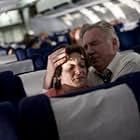A real-time account of the events on United Flight 93, one of the planes hijacked on September 11th, 2001 that crashed near Shanksville, Pennsylvania when passengers foiled the terrorist plo... Read allA real-time account of the events on United Flight 93, one of the planes hijacked on September 11th, 2001 that crashed near Shanksville, Pennsylvania when passengers foiled the terrorist plot.A real-time account of the events on United Flight 93, one of the planes hijacked on September 11th, 2001 that crashed near Shanksville, Pennsylvania when passengers foiled the terrorist plot.
- Nominated for 2 Oscars
- 29 wins & 57 nominations total
- Waleska Martinez
- (as Liza Colon-Zayas)
- Deora Frances Bodley
- (as Trieste Dunn)
- Director
- Writer
- All cast & crew
- Production, box office & more at IMDbPro
Storyline
Did you know
- TriviaTo make the movie as authentic as possible, director Paul Greengrass cast a number of real-life participants in the events of September 11, 2001, to play themselves. The principal "real-life role" in the movie is Ben Sliney, the FAA's National Operations Manager, who made the decision on 9/11 to shut down all air traffic operations in the United States. Sliney had just been promoted to the National Operations Manager position, and September 11, 2001 was his first day on the job. That explains the applause from the FAA flight monitors when he walks into the control center in Herndon, VA, at the beginning of the movie. Several officials who were with Sliney in the FAA control room on 9/11 play themselves, including Tobin Miller, Rich Sullivan, and Tony Smith. In the scenes at Newark Airport, several air traffic controllers who were in the Newark control tower on 9/11, and who witnessed the air attacks on the World Trade Center, play themselves. At the air traffic monitoring centers in Boston, New York, and Cleveland, the air traffic monitors are all played by real-life air traffic controllers, including several who were at these locations on 9/11, and who monitored the hijacked flights. At the Northeast Air Defense Command Center (NEADS) in Rome, NY, most of the military personnel are played by real-life military air traffic controllers, including several people, notably Major James Fox, who were at NEADS on 9/11. Also, on United Flight 93, the actors playing the pilots in the movie are real-life airline pilots, and the flight attendants are played by real-life flight attendants, some of whom work for United Airlines.
- GoofsAt the start of the movie, passengers arriving at the gate at Newark Airport are clearly at the domestic departure gates at Stansted Airport, Essex, UK. The scene includes BAA signage, seating at the gate (17), the rail link to the international departure gates (seen through the glass at the security checkpoint) and a "2 for £25" advertisement on the passenger walkway towards the gates.
- Quotes
Honor Elizabeth Wainio: Hi, Mom, it's me. I'm on the plane that's been hijacked. I'm just calling to tell you that I love you, and goodbye. This really kind woman handed me the phone and she said to call you.
- Crazy creditsThe very last line of closing credits states that the movie was "not sponsored by, or in any way affiliated with, United Airlines."
- ConnectionsFeatured in Siskel & Ebert: The Best Films of 2006 (2006)
- mlambertint
- Jul 5, 2006
- How long is United 93?Powered by Alexa
Details
- Release date
- Countries of origin
- Official site
- Languages
- Also known as
- Flight 93
- Filming locations
- Production companies
- See more company credits at IMDbPro
Box office
- Budget
- $15,000,000 (estimated)
- Gross US & Canada
- $31,483,450
- Opening weekend US & Canada
- $11,478,360
- Apr 30, 2006
- Gross worldwide
- $76,700,659
- Runtime1 hour 51 minutes
- Color
- Sound mix
- Aspect ratio
- 2.39 : 1
Contribute to this page











































